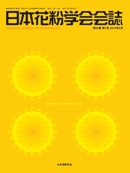Volume 62, Issue 2
Displaying 1-30 of 30 articles from this issue
- |<
- <
- 1
- >
- >|
-
2017Volume 62Issue 2 Pages Cover1-
Published: March 31, 2017
Released on J-STAGE: December 18, 2023
Download PDF (357K) -
2017Volume 62Issue 2 Pages Toc1-
Published: March 31, 2017
Released on J-STAGE: December 18, 2023
Download PDF (1058K) -
2017Volume 62Issue 2 Pages 39
Published: March 31, 2017
Released on J-STAGE: December 18, 2023
Download PDF (894K) -
2017Volume 62Issue 2 Pages 41-74
Published: March 31, 2017
Released on J-STAGE: December 18, 2023
Download PDF (1264K) -
2017Volume 62Issue 2 Pages 75-85
Published: March 31, 2017
Released on J-STAGE: December 18, 2023
Download PDF (1875K) -
2017Volume 62Issue 2 Pages 87-92
Published: March 31, 2017
Released on J-STAGE: December 18, 2023
Download PDF (1280K) -
2017Volume 62Issue 2 Pages 93-103
Published: March 31, 2017
Released on J-STAGE: December 18, 2023
Download PDF (1091K) -
2017Volume 62Issue 2 Pages 105-109
Published: March 31, 2017
Released on J-STAGE: December 18, 2023
Download PDF (1385K) -
2017Volume 62Issue 2 Pages 111-118
Published: March 31, 2017
Released on J-STAGE: December 18, 2023
Download PDF (1121K) -
2017Volume 62Issue 2 Pages 119
Published: March 31, 2017
Released on J-STAGE: December 18, 2023
Download PDF (840K) -
2017Volume 62Issue 2 Pages 120-121
Published: March 31, 2017
Released on J-STAGE: December 18, 2023
Download PDF (969K) -
2017Volume 62Issue 2 Pages 121-122
Published: March 31, 2017
Released on J-STAGE: December 18, 2023
Download PDF (968K) -
2017Volume 62Issue 2 Pages 122-123
Published: March 31, 2017
Released on J-STAGE: December 18, 2023
Download PDF (969K) -
2017Volume 62Issue 2 Pages 123
Published: March 31, 2017
Released on J-STAGE: December 18, 2023
Download PDF (965K) -
2017Volume 62Issue 2 Pages 123-125
Published: March 31, 2017
Released on J-STAGE: December 18, 2023
Download PDF (1051K) -
2017Volume 62Issue 2 Pages 125-127
Published: March 31, 2017
Released on J-STAGE: December 18, 2023
Download PDF (965K) -
2017Volume 62Issue 2 Pages 128-129
Published: March 31, 2017
Released on J-STAGE: December 18, 2023
Download PDF (908K) -
2017Volume 62Issue 2 Pages 130
Published: March 31, 2017
Released on J-STAGE: December 18, 2023
Download PDF (902K) -
2017Volume 62Issue 2 Pages 131
Published: March 31, 2017
Released on J-STAGE: December 18, 2023
Download PDF (965K) -
2017Volume 62Issue 2 Pages 131-134
Published: March 31, 2017
Released on J-STAGE: December 18, 2023
Download PDF (976K) -
2017Volume 62Issue 2 Pages 136
Published: March 31, 2017
Released on J-STAGE: December 18, 2023
Download PDF (1147K) -
2017Volume 62Issue 2 Pages 137
Published: March 31, 2017
Released on J-STAGE: December 18, 2023
Download PDF (905K) -
2017Volume 62Issue 2 Pages 138
Published: March 31, 2017
Released on J-STAGE: December 18, 2023
Download PDF (805K) -
2017Volume 62Issue 2 Pages 139
Published: March 31, 2017
Released on J-STAGE: December 18, 2023
Download PDF (988K) -
2017Volume 62Issue 2 Pages 140
Published: March 31, 2017
Released on J-STAGE: December 18, 2023
Download PDF (902K) -
2017Volume 62Issue 2 Pages 141
Published: 2017
Released on J-STAGE: December 18, 2023
Download PDF (849K) -
2017Volume 62Issue 2 Pages 141
Published: March 31, 2017
Released on J-STAGE: December 18, 2023
Download PDF (849K) -
2017Volume 62Issue 2 Pages 141
Published: March 31, 2017
Released on J-STAGE: December 18, 2023
Download PDF (849K) -
2017Volume 62Issue 2 Pages Toc2-
Published: March 31, 2017
Released on J-STAGE: December 18, 2023
Download PDF (906K) -
2017Volume 62Issue 2 Pages Cover2-
Published: March 31, 2017
Released on J-STAGE: December 18, 2023
Download PDF (357K)
- |<
- <
- 1
- >
- >|
